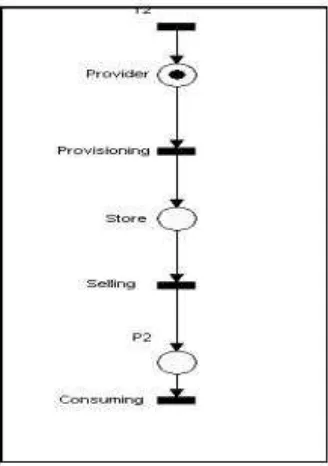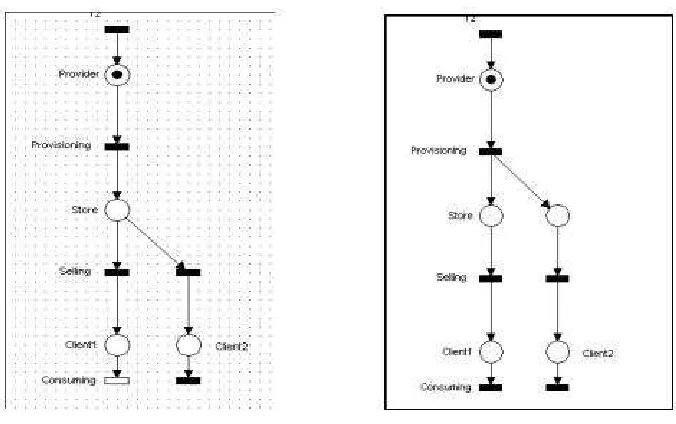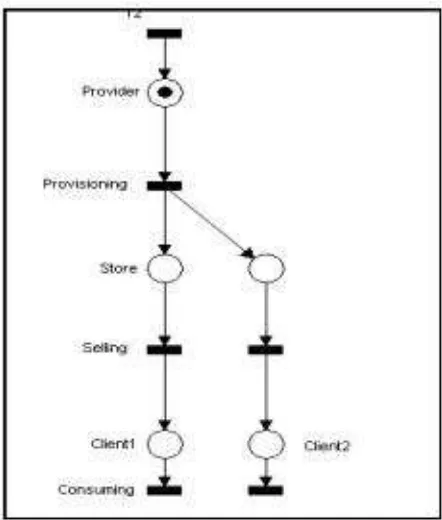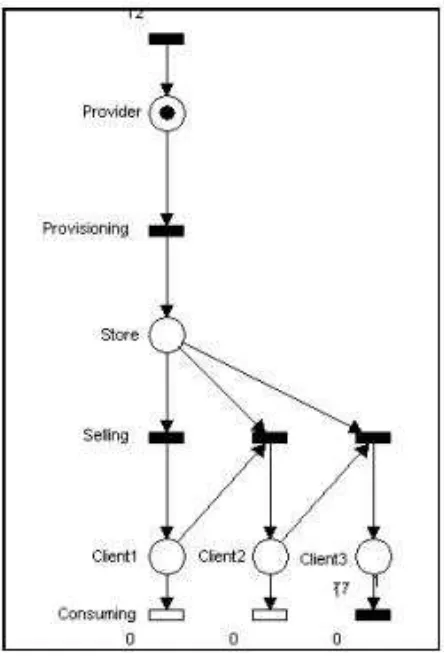Mathematics and Informatics ICTAMI 2005 - Alba Iulia, Romania
PETRI NETS FOR MODELING A SUPPLY CHAIN MANAGEMENT PROCESS
Eduard Edelhauser and Marius Toth
Abstract. We chose Petri Nets to use for modeling a manufacturing enterprise, in fact the supply chain management process (SCM) that is sub-ject to unexpected events for which reactions are required. Usually Petri Nets are used for describing and studying systems that are characterized as be-ing concurrent, asynchronous, distributed, parallel, nondeterministic, and/or stochastic. We described also a classic software for Enterprise Resource Plan-ning (ERP) offered by SAP, which has also a module (software division) for SCM called mySAP SCM. We will try to offer a modest alternative solution for a SCM using Petri Nets.
1. What is a Supply Chain Management Process (SCM )
Since its inception in the early 1990’s, the field of supply chain management has become tremendously important to companies in an increasingly compet-itive global marketplace. The term supply chain refers to the entire network of companies that work together to design, produce, deliver, and service prod-ucts. In the past, companies focused primarily on manufacturing and quality improvements within their four walls; now their efforts extend beyond those walls to encompass the entire supply chain.
Figure 1: Three Flows: Materials, Information, and Financial 2. Supply Chain Management Tools offered by SAP - mySAP
SCM
Who is SAP?Founded in 1972, SAP is the recognized leader in providing collaborative business solutions for all types of industries and for every major market. With 12 million users, 96,400 installations, and more than 1,500 partners, SAP is the world’s largest inter-enterprise software company and the world’s third-largest independent software supplier overall. They have a rich history of innovation and growth that has made us a true industry leader. Today, SAP employs more than 32,000 people in more than 50 countries.
What is SCM for SAP? As most chores within the supply chain today cannot do without the use of computer software, the SCM designed by SAP shows concrete examples using SAP within different industry areas. Since SAP is emphasizing recent developments in operations management in its SCM ini-tiative, it describes the methodological background from the viewpoint of a company using SAP systems, order processing both in an intra and inter orga-nizational perspective, as well as describing future developments and system enhancements. In an age of intense competition, supply chain efficiency and adaptability are not just requirements for success. They are necessities for survival.
About mySAP. mySAP Supply Chain Management (mySAP SCM) can help your organization transform a linear supply chain into an adaptive sup-ply chain network, in which communities of customer-centric, demand-driven companies share knowledge, intelligently adapt to changing market conditions, and proactively respond to shorter, less predictable life cycles.
chain solution that integrates collaboration, planning, execution, and coordi-nation of the entire supply chain network ( SAP opinion) - empowering with: • Synchronize supply to demand – Balance push and pull network planning processes. Replenish inventory and execute production based on actual demand.
• Sense and respond with an adaptive supply chain network – Drive distri-bution, transportation, and logistics processes that are integrated with real-time planning processes.
• Provide network wide visibility, collaboration, and analytics – Monitor and analyze your extended supply chain.
3. The Petri Nets as a modeling tool
A Petri net is a mathematical representation of discrete distributed sys-tems. Petri nets were defined in the 1960s by Carl Adam Petri. Because of their ability to express concurrent events, they generalize automata theory. The concept of Petri nets has its origin in Carl Adam Petri’s dissertation Kom-munikation mit Automaten, submitted in 1962 to the faculty of Mathematics and Physics at the Technische Universit¨at Darmstadt, Germany.
Petri nets are a promising tool for describing and studying systems that are characterized as being concurrent, asynchronous, distributed, parallel, nonde-terministic, and/or stochastic. As a graphical tool, Petri nets can be used as a visual-communication aid similar to flow charts, block diagrams, and net-works. In addition, tokens are used in these nets to simulate the dynamic and concurrent activities of systems. As a mathematical tool, it is possible to set up state equations, algebraic equations, and other mathematical models governing the behavior of systems.
Definition 1. A Petri Net is a bipartite directed graph represented by a quadruple
P N = (P, T, I, O) where:
P ={p1, ..., pn} is a finite set of places. T ={t1, ..., tm} is a finite set of transitions.
I(p, t) is a mappingP´T{0,1}corresponding to the set of directed arcs from places to transitions.
O(t, p)is a mappingT´P{0,1}corresponding to the set of directed arcs from transitions to places.
The nets under consideration, where I and O take the values of 0 or 1, are called ordinary Petri Nets.
4. Modeling a supply chain process using Petri Nets
We shall use Petri Nets for modeling a very simple (scholastic) supply chain process. We have a very simple supply chain process.
To design a simulation we shall use a new transition called consuming placed at the end of the chain. This will create a deadlock (blocking state), so we have to consider that the client will consume the buying product.
Figure 2: Simple supply chain process
[image:5.612.100.264.358.591.2]Figure 4: Two client supply chain process
[image:6.612.97.436.437.566.2]Figure 6: Two client supply chain process hawing two store nodes
In this case (figure 4) we have a conflict – confusing situation. When one of the two store nodes is marked in “Store” (figure 5), we can not predict which of the two clients will be satisfied, so it is a random situation.
For solving this situation we can use two methods:
1. Introducing a new node on the Store level, so we shall insert a new resource which will bring us to the following situation:
2. Using a special transition category called temporized transition. These transitions are not executed on each execution step, but only at a defined number of steps. This will mean that it will exists an agreement between the clients, so a new demand of supply will be made not instantly after the use of previous supply, but with a specified delay.
Figure 7: Multi client supply chain process
This regulation of the clients create a FIFO list , which will apply for 1 to n clients. The next figure will show 3 clients, which will be satisfied in a temporized order.
5. Conclusions
References
[1] Toth Marius, Baleanu Virginia, Edelhauser Eduard, Modeling a Pro-duction Process using Petri Nets, Bulletins for Applied and Computer Math-ematics (BAM), PAMM B.almadi, May 2005
[2] Egri Angela, Toth Marius ,Flexible Manufacturing System modeling and simulation with Petri Nets, Micro CAD International Scientific Conference, University of Miskolc, Hungary, March 2002
[3] Fox M.S.; Barbuceanu M.; Teigen R., Agent-Oriented Supply-Chain Management, International Journal of Flexible Manufacturing Systems, April 2000, vol. 12,
[4] Jucan Toader, Ferucio Laurent¸iu T¸ iplea, Petri Nets Theory and Prac-tice, Romanian Academy Publishing House Romˆane, Bucharest, 1999.
[5] Knolmayer, Gerhard, Mertens, Peter, Zeier, Alexander , Supply Chain Management Based on SAP Systems, Order Management in Manufacturing Companies ,Series: SAP Excellence 2002, Hardcover,ISBN: 3-540-66952-3
Eduard Edelhauser
University of Petrosani, Romania email:edi1ro2001.yahoo.com Marius Toth




